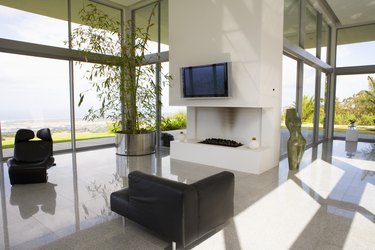
Fireplaces and fire pits are hypnotic people magnets. The warmth of a fire and glow of flames is irresistible. Fire glass and logs "up" the aesthetic and magical qualities that fireplaces and fire pits can create. Fire glass adds color and makes flames seem like they're dancing. Fire logs can make a gas fireplace so realistic that you'd think you were looking at a real wood-burning fireplace. Both are good solutions for those who seek more environmentally-friendly fire products.
Fire Glass
Video of the Day
Think of a color you'd like to see in your fireplace or fire pit and chances are there's a fire glass in just the color you want. Fire glass gives you the ability to coordinate the look of your fire with the colors in your décor. The glass is shaped like small rocks or beads. Color choices are almost endless and have luminescent qualities that will make your fire exotic and romantic. Fire glass looks exceptionally smart and sophisticated in modern homes. Picture a three-way fireplace or a sunken unit with bright red, turquoise or emerald green glass surrounding the flame and that can withstand temperatures up to 1,300 degrees F. Tearing your guests away from the fire will be difficult – let alone yourself and your family.
Video of the Day
Fire Logs
You have to log choices with wood-burning and gas-operated fireplaces: real or artificial. You can walk into a room and tell if a fireplace is wood burning without even seeing it because the smell of the wood is unmistakable. Maximize your heating efficiency by choosing the right wood species for logs. According to Hearth.com, the top five are hickory, East hop hornbeam, apple, white oak and sugar maple. These five are denser, weigh more per cord and generate more British Thermal Units (BTUs) of heat. Gas logs, on the other hand, transform what is essentially a heater to make it look like a fireplace. Many logs are made of ceramic materials and have vented openings from which the flame from the gas burners rise. You can even find gas logs that hide the blue flame of the gas burner and emit a golden flame and the logs look red and hot, getting pretty close to the look of a real wood log-burning fireplace.
Similarities and Advantages
Fire glass and gas logs eliminate several environmental and indoor air quality issues. Neither one emits smoke, toxic fumes or odors, and, you don't have to worry about embers falling onto floors and carpets with gas logs and glass since they don't have to be moved around or adjusted as is the case with real wood logs. Glass and gas are also more environmentally friendly. They are combined with gas logs to give a fireplace functionality and beauty at the same time. Fire glass is most often made of recycled glass, making it an environmentally-friendly choice. While gas logs themselves don't generate the heat, they provide just the right camouflage for the gas or propane burners to heat a room as hot as you want it.
Differences
While glass adds a look of class and mystique and gas is high on efficiency, heat disbursement and convenience, wood logs provide aesthetic and authenticity qualities that gas and glass cannot. Wood logs are real, not manufactured like gas logs. Wood has a heritage and association with fireplaces that hearkens back to the days when cave dwellers walked the Earth – unlike glass. You can just imagine a group of cave dwellers meeting around a wood-burning fireplace and finalizing their plans to create the wheel. Neither glass nor gas can make that claim. Also possible is that one day gas and glass will be replaced by some other new materials. However, no matter what's new and next, wood will always be the standard against which all other fireplace logs are measured.